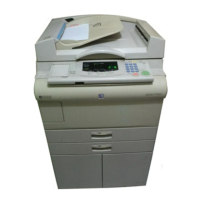1.1.3 Process Control Procedures
This section outlines how the machine controls the copy process based on
the inputs from various sensors.
1.1.3.1 Copy Image Control
This is how the machine adjusts copy processes based on settings input at
the operation panel.
- Manual ID Correction -
If the user inputs the image density manually, the machine adjusts the
exposure lamp voltage and the development bias to achieve the selected
image density.
- Reproduction Ratio Correction -
If the user selects a 116% or greater enlargement ratio or a 50% reduction
ratio, the machine corrects the development bias to compensate for the loss
in light intensity reaching the drum.
- ADS Pattern Detection and ADS Correction -
If the user selects Auto Image Density (ADS) mode, the machine monitors
the output from the ADS sensor and adjusts the development bias to
compensate for variations in ADS sensor response. This prevents dirty
background.
Every 1,000 copies, the machine calibrates the ADS sensor output by
reading the white ADS pattern under the left scale of the exposure glass.
The ADS sensor must also be recalibrated:
• If the drum is changed
• If the ADS sensor is cleaned or changed
• If the exposure lamp or optics are cleaned or changed.
1.1.3.2 Image Density Control
This is how the machine corrects the concentration of toner in the developer
based on readings from the ID (Image Density) and TD (Toner Density)
sensors.
- V
SP
and V
SG
Detection/ID Correction -
The machine uses V
SP
and V
SG
readings by the ID sensor, along with
readings from the toner density sensor, to determine if the toner
concentration in the developer is at the optimum level.
Rev. 6/95
Detailed
Descriptions
STM 2-5 A156/A160/A162

